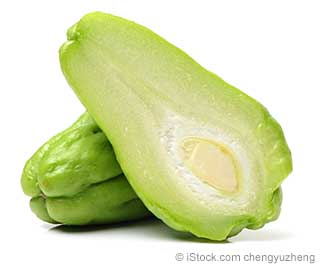Healthy food and cooking in Vietnam
Subscribe to the topic
Post new topic
I am very pleasantly surprised at what I found on the cu nghe. It is much more capable as a medicine than what I thought.
Trai su su (chayote squash, a member of the cucurbit family)
This squash variety is incredibly prolific. If you like its mild flavor, it will provide more fruit than you can possibly eat. In addition, you can eat the new shoots and leaves as a steamed or boiled green. It also produces tubers in the root system. You are almost forced to keep them trimmed to keep the vine from taking over the garden.
Wiki: Eat the Chayote. ... It can be eaten raw or steamed, boiled, baked, stuffed, fried, and marinated. It is quite good for you and is high in vitamin C, folate, fiber, and various trace minerals.
Chayotes have a mild cucumber-like flavor and can be prepared in any way you might use summer squash, raw or cooked. Chayote skin is edible but not as tender as its flesh, so peeling is usually a good idea. The seed in the center of the fruit is also edible.
The only thing difficult about growing su su is getting it to sprout. Place a su su from the market on a shelf out of direct sunlight. In a week or two it will send out a stalk which is the start of the vine. At this time place it in a pot of rich soil at an angle with the stem above ground. Keep the soil moist but not wet. After another two weeks or so transplant it into your garden, taking care to not disturb the roots too much. Stand back.
Chayote recipes
Amount Per 100 grams
Calories 19
% Daily Value*
Total Fat 0.1 g 0%
Saturated fat 0 g 0%
Polyunsaturated fat 0.1 g
Monounsaturated fat 0 g
Cholesterol 0 mg 0%
Sodium 2 mg 0%
Potassium 125 mg 3%
Total Carbohydrate 4.5 g 1%
Dietary fiber 1.7 g 6%
Sugar 1.7 g
Protein 0.8 g 1%
Vitamin A 0% Vitamin C 12%
Calcium 1% Iron 1%
Vitamin D 0% Vitamin B-6 5%
Cobalamin 0% Magnesium 3%
Jim-Minh wrote:Trai su su (chayote squash, a member of the cucurbit family)
[img align=L]https://media.mercola.com/assets/images/foodfacts/chayote.jpg[/url]
This squash variety is incredibly prolific. If you like its mild flavor, it will provide more fruit than you can possibly eat. In addition, you can eat the new shoots and leaves as a steamed or boiled green. It also produces tubers in the root system. You are almost forced to keep them trimmed to keep the vine from taking over the garden.
Wiki: Eat the Chayote. ... It can be eaten raw or steamed, boiled, baked, stuffed, fried, and marinated. It is quite good for you and is high in vitamin C, folate, fiber, and various trace minerals.
Chayotes have a mild cucumber-like flavor and can be prepared in any way you might use summer squash, raw or cooked. Chayote skin is edible but not as tender as its flesh, so peeling is usually a good idea. The seed in the center of the fruit is also edible.
The only thing difficult about growing su su is getting it to sprout. Place a su su from the market on a shelf out of direct sunlight. In a week or two it will send out a stalk which is the start of the vine. At this time place it in a pot of rich soil at an angle with the stem above ground. Keep the soil moist but not wet. After another two weeks or so transplant it into your garden, taking care to not disturb the roots too much. Stand back.
Chayote recipes
Amount Per 100 grams
Calories 19
% Daily Value*
Total Fat 0.1 g 0%
Saturated fat 0 g 0%
Polyunsaturated fat 0.1 g
Monounsaturated fat 0 g
Cholesterol 0 mg 0%
Sodium 2 mg 0%
Potassium 125 mg 3%
Total Carbohydrate 4.5 g 1%
Dietary fiber 1.7 g 6%
Sugar 1.7 g
Protein 0.8 g 1%
Vitamin A 0% Vitamin C 12%
Calcium 1% Iron 1%
Vitamin D 0% Vitamin B-6 5%
Cobalamin 0% Magnesium 3%
You should open your own website for this topic.
Maybe you could earn money with placed advertisements. 
Medicinal uses of the chayote included a tea made of the leaves is reported to dissolve kidney stones as well as a treatment for arteriosclerosis and hypertension.
The chayote can be eaten raw in salads or stuffed and baked. Other preparations include mashing, pickling, frying or boiling. The plain squash tends to be bland and benefits from "aggressive" seasoning. You can see a recipe here for sauteed chayote leaves and tendrils. You can also eat the chayote tuber portion of the roots boiled or you can add it to a simple vegetable or meat stew.
I'll bet they would be good french fried as well.
I have just read that Spain has replaced Italy as the healthiest country.
The main reason that these 2 countries are the healthiest countries in the world is the Mediterranean cuisine with lots of extra virgin olive oil.
I wonder if it would not be possible to grow olive trees here in Vietnam.
Isn't the climate here suitable for olive trees?
I know that the good olive trees are very old and that therefore it would take a lot of patience to plant olive trees.
But someone has to be the first. 
The only downside may be that while olives do require frost free environment, they also prefer dry summers and of course summer is the rainy season in Vietnam. As they can be grown from seed, as opposed to grafted parts, you could probably import seeds from Europe, but you might want to check on the legality with agricultural authorities first. As far as I know Andy, you are one of the few contributors here who lives in the countryside. Perhaps you need to be the first to try. 
Andy Passenger wrote:I have just read that Spain has replaced Italy as the healthiest country.
The main reason that these 2 countries are the healthiest countries in the world is the Mediterranean cuisine with lots of extra virgin olive oil.
I wonder if it would not be possible to grow olive trees here in Vietnam.
Isn't the climate here suitable for olive trees?
I know that the good olive trees are very old and that therefore it would take a lot of patience to plant olive trees.
But someone has to be the first.
Olive trees are susceptible to fungal infections. I'm afraid Vietnam doesn't have a hot and dry enough microclimate anywhere to cultivate them properly. I am sure it would be much easier to just import the Mediterranean extra virgin olive oil.
From a Google search:
Olive trees require a Mediterranean-like climate to survive. They need a long, hot summer and a cool, not frigid, winter. A mature tree can survive temperatures down to 15 degrees Fahrenheit for a limited amount of time; sustained cold below 15 degrees can be fatal. There are olive trees that survive outside of the typical Mediterranean zone but generally, they do not produce economically viable crop levels.
There are many growing regions that are appropriate for olives, although each microclimate should be considered thoroughly before planting occurs. In particular, tree growers in locales that are on the edge of a good territory can have a more restrictive palate of trees from which to choose. In regions where the summers are cool or short, it is safer to choose early-ripening varieties that will accumulate enough oil in the fewer months of heat. Growers with colder winters should look for cultivars that come originally from mountainous or cooler regions. Growers who are very close to the ocean or who experience a great deal of fog should lean away from varieties that are susceptible to leaf fungal infections. The IOC’s World Catalogue of Olive Varietals is one resource for this information as are other growers in your immediate vicinity who may have local insight.
Just had an after the fact thought. If olive trees worked in Vietnam, the French colonists would have planted them extensively.
THIGV wrote:Just had an after the fact thought. If olive trees worked in Vietnam, the French colonists would have planted them extensively.
Right on. Michelin planted millions of rubber trees because Vietnam's climate was perfect for that purpose.
Jim-Minh wrote:Medicinal uses of the chayote included a tea made of the leaves is reported to dissolve kidney stones as well as a treatment for arteriosclerosis and hypertension.
The chayote can be eaten raw in salads or stuffed and baked. Other preparations include mashing, pickling, frying or boiling. The plain squash tends to be bland and benefits from "aggressive" seasoning. You can see a recipe here for sauteed chayote leaves and tendrils. You can also eat the chayote tuber portion of the roots boiled or you can add it to a simple vegetable or meat stew.
I'll bet they would be good french fried as well.
Here in Australia they are called chokos and my Mum always had them in the garden. We never ate them raw. At times when money was short, Mum would stew them with sugar and spices and the flavour was very similar to stewed pears. In fact, people often referred to them as "Choko pears". I think they were eaten a lot during the Depression and WW2.
THIGV wrote:The only downside may be that while olives do require frost free environment, they also prefer dry summers and of course summer is the rainy season in Vietnam. As they can be grown from seed, as opposed to grafted parts, you could probably import seeds from Europe, but you might want to check on the legality with agricultural authorities first. As far as I know Andy, you are one of the few contributors here who lives in the countryside. Perhaps you need to be the first to try.
I guess I'll have to forget the whole thing. I have read that olives do not grow in tropical climates.
I would also have to find seedlings or fresh olives here in Vietnam. Seeding well from Europe is rather difficult, because I will not go to Europe in the near future and because I do not want to violate import regulations regarding foreign seeds.
I found my Italian favourite olive oil in various shops. But the prices are partly very high, but I found a shop where the price is just affordable.
But if I find fresh olives or seedlings, I will try it anyway, because the olive trees also make optical (without usable fruits) joy.
Rapeseed oil is also very healthy.
But I guess I don't have enough acreage for that. 
Andy Passenger wrote:I guess I'll have to forget the whole thing. I have read that olives do not grow in tropical climates.
Although Vietnam is technically in the tropical band its climate is more like what is called sub-tropical as it has a fair bit of seasonality. Its just that the rain in the wrong half.
Andy Passenger wrote:But if I find fresh olives or seedlings, I will try it anyway, because the olive trees also make optical (without usable fruits) joy.
That's the spirit. 
Andy Passenger wrote:Rapeseed oil is also very healthy.
But I guess I don't have enough acreage for that.
I have not direct, but observed experience with rapeseed in the seed research business in Hawaii where I worked for years and it did not go well. Losses to fungal diseases were intolerable for the grower. In this case the researchers were trying to produce a winter generation, but in Hawaii winter is the rainy season. Commercial rapeseed is in very cool and preferably rather dry climates. Most rapeseed production in North America is in the plains of Canada, certainly not much like Vietnam.
As you allude to above, one thing that most people who are not commercial farmers don't take into account is the large amount of space needed to produce relatively little of what are called commodity crops. Your annual rapeseed or olive oil needs would probably consume several hectares. Better stick to a few olive trees for fun and also for direct consumption, not for oil. That could also factor in to which varieties you choose it you did look for seeds on a trip to Europe. There probably are varieties that are more for oil and others that are more to be eaten fresh or pickled. Don't give it up yet. 
Articles to help you in your expat project in Vietnam
 Dating In Vietnam
Dating In VietnamIf you're considering moving to Hanoi, or Ho Chi Minh City, the dating scene may be of interest to you. ...
 Making phone calls in Vietnam
Making phone calls in VietnamThe telecommunications sector in Vietnam has flourished throughout the past two decades. Like many foreigners, ...
 Moving to Vietnam with your pet
Moving to Vietnam with your petIf you are planning to move to Vietnam with a pet, there are a number of formalities that have to be completed ...
 Driving in Vietnam
Driving in VietnamVietnam is known for four categories of lush and diverse landscapes, and one of the easiest ways to see firsthand ...
 Getting married in Vietnam
Getting married in VietnamHave you met that perfect someone who you want to spend the rest of your life with? Luckily, getting married in ...
 Sports activities in Hanoi
Sports activities in HanoiWe know there's a lot of attention on the drinking culture in Hanoi, but what about the options for a healthy ...
 Working in Vietnam
Working in VietnamAnyone thinking about working in Vietnam is in for a treat. Compared to many Western countries, Vietnam's ...
 The most popular neighbourhoods in Hanoi
The most popular neighbourhoods in HanoiFormerly known as Thang Long, Vietnam's present capital city was renamed Hanoi in 1831. This enchanting, ...
Find more topics on the Vietnam forum



